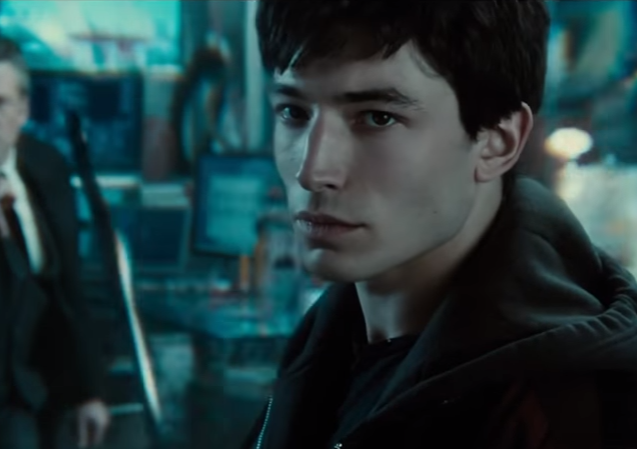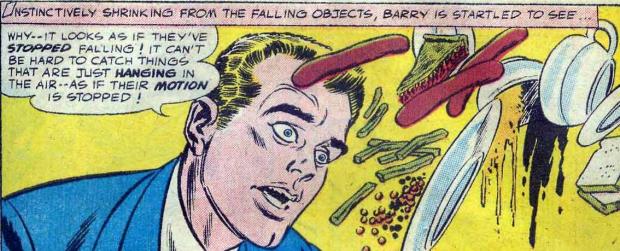The Flash is really fast. The trailer for Justice League is cool.
Let’s put the two together, shall we? Just how fast is the Flash in the footage for the upcoming Justice League movie that was released at Comic Con?
Just to set the stage – the trailer (below) shows Bruce Wayne traveling the world, gathering his ream of “people with special abilities” to battle a coming evil. In his travels, Wayne approaches Aquaman (Arthur Curry, played by Jason Momoa), Cyborg (Vic Stone, played by Ray Fisher), and the Flash (Barry Allen, played by a chatty Ezra Miller).
After sneaking into Allen’s lab, Bruce “tests” Barry as only Bruce would – by throwing a Batarang right at him. It’s a nice moment – Bruce throws, and Barry instantly goes into his “speed” mode. Alan Moore once described the Flash as “a man who moves so fast that his life is an endless gallery of statues,” and we see that here. Bruce’s Batarang tumbles through the air, Barry easily dodges, and in some great acting, you can see the whole story dawn on Barry – this guy is Batman, and this is some of that cool super-hero stuff he’s seen…and wants to be a part of.
What can we tell from this little snippet of film? Well, we can’t figure out how fast the Flash runs in the DC Cinematic Universe, or his metabolism, or anything like that. What we can do, with a little math, is get an idea on what the world is like for Barry Allen, living in his “endless gallery of statues.”
To do this, we’re going to need to know a little bit about knife throwing, and keep track of some time.
According to The Great Throwdini (David Adamovich), the world’s fastest and most accurate knife thrower, there’s a fair amount of physics involved in throwing a knife. It’s all a game of distances, rotations and types of throws. For stage throws, and most competitions and popular knife throwing, there are three types of throws: no-spin, half-spin and full-spin. More than full spin requires distance and faster throws, but is all based on the same idea. From the video, it’s easy to see that the Batarang is spinning, so we can dismiss the techniques of no-spin knife throwing.
If you’re throwing a blade that’s spinning and you want it to stick into your target, whether that’s an actual target or a bad guy (if you’re Batman), or a potential Justice League recruit (again, if you’re Batman…what if he had been wrong about Barry?). That means that the knife has to hit the target point first. It sounds simple, but there’s a technique to it. The basic “basics” come in when you figure out how to hold the knife – by the blade or by the handle if the knife is perfectly balanced, which Batarangs are. For other knives, you want to throw the heavy end first, so you hold the lighter side, either the blade or the handle, depending upon the knife. (Please note – this is in no way a tutorial on how to throw a knife. If you want one of those, go here.)
The knife will spin during flight, and again – you want the number of rotations to work out so that the point (either end of a Batarang) hits the target first.
Getting away from knife-throwing and back to the original question – how is any of this going to help us figure out what it’s like to be the Flash?
We need some kind of ratio – something which expresses the time in our world versus the time in “Flash world,” that is, when Barry Allen is “at speed.”
By the way – that “at speed” is something that Barry Allen has been able to do since the very beginning – as shown in Showcase #4 and mirrored in the first episode of CW’s The Flash. When Barry’s super-speed kicks in, his perceptions of the world around him change. Everything, as seen through his eyes, is moving super-slow, if at all (again, Moore’s “gallery of statues”). It’s a visual trick to show that the Flash is moving super-fast. When you’re super-fast, everything else is slow.
So – that ratio. What can we look at to get it?
Well, from the trailer, Bruce’s throw (in Barry’s eyes) lasts roughly 21 seconds – there’s wiggle room there, because, as filmed, the Flash is moving in slower motion than normal. Also – there were a couple of cuts in the sequence, so your measured time may be a little different. If you watch the “throw” sequence again, you’ll see that Barry dodges the Batarang by moving to his right, and forward a half step. As he watches, the Batarang levels out, and one of its business ends it exactly where Barry’s forehead was moments (for him) earlier. Again – what if Bruce was wrong? Or – maybe he was wrong on the four other guys named “Barry Allen” in four different cities in the DCU…
Ahem, anyway…let’s just settle that for the Flash, the throw took 21 seconds. Got it.
How long did it take in Bruce’s world?
Going back to The Great Throwdidni, he explains that a thrown knife when he’s been measured is somewhere between 22 and 30 miles per hour, although they can travel faster. Let’s assume that Bruce – he is at the peak of human abilities right? – is at the top of that range, and throws his Batarangs at 30 miles an hour (44 feet per second).
Okay – how far was Bruce throwing?
We can estimate the distance as seen in the trailer (ballpark…10 feet? Twelve?), but also, we can look for some help. Grant Thompson, YouTube’s “The King of Random” actually made Batarangs back in 2014, and, if the video below is true: 1) home-made Batarangs can look pretty swanky, and 2) he got pretty good with them (we’d rate him a solid Nightwing) in a short amount of time. As Thompson explains in his video, three steps/paces from the target gives one rotation of the Batarang before it hits the trailer, and to ensure two rotations before hitting, he walked back six steps/paces.
You want to watch this – but if you make Batarangs on your own, be careful!
The U.S. Army (a group that knows their paces) sets a “pace” at 30 inches on average, so six paces would be (6 x 30) 180 inches or (180/12) 15 feet, which seems a little far, but okay.
If Bruce is throwing along the same lines as Thompson, we should see the Batarang rotate twice in the throw before it’s sharp end is where Barry’s forehead was. Given the couple of cuts in the scene, being definite on the number of turns is tricky, but we’re going with two. There’s a bit of a turn started after it passes where Barry’s forehead was (the target), which we’ll let go for now. Barry actually caught the Batarang a little bit past where he was standing, when he reached out for it, so Bruce’s release to Barry’s catch very well could be 15 feet.
As always, your mileage may vary – if it does, come on over to the Facebook thread and let us know.
We’ve got how fast the Batarang was moving – 44 feet per second. We’ve got how far it was traveling – 15 feet. Figuring out time is easy:
Speed = distance/time – rearrange to solve for time – time = distance/speed.
With numbers:
Time = 15 feet/44 feet/second
Time = .34 seconds.
In other words, in Bruce’s world, from the time he threw the Batarang until Barry caught it, .34 seconds or 340 milliseconds passed. Let’s put that in perspective – an average human eye blink lasts 300 – 400 milliseconds. As far as Bruce saw, Barry literally caught the Batarang “in the blink of an eye.”
Yeah, the Flash is fast.
So what does this all mean – what final step can we take with this stuff?
The throw took 21 seconds in the Flash’s world, and .34 in Bruce’s world. What’s that ratio?
21 seconds/.34 = 61.8
We’re not locking this in as an “always has to be” for the Flash, but in this instance, when Bruce threw the Batarang, time slowed for the Flash by a factor of about 62. In other words, when the Flash is “at speed” in the same way as shown here, 1 second in our world equals roughly 62 in his. One minute for us, a shade over an hour for him, if he’s “at speed” the whole time.

Pretty sweet, huh?
Yeah – if a Batarang is coming toward your head, or you need to say, punch someone a lot in a very short amount of time. But for “re-claiming” that time when you’re “at speed” to do something useful?
Say the Flash takes one minute of “our time” at speed. Based on average reading rates, that’s enough time to get about 12,000 words into a novel (if the pages could bear the stress of being turned that fast), or say, write a paper with a pen or pencil – although the pencil would grind down quickly, and the friction between the pen/pencil and paper could be enough to set the paper on fire. Flash could only do things “at speed” with objects that did not otherwise have speed limitations, such as a computer. Surfing on the internet would be as boring as it used to be on dial-up – click and wait for the processor (even a fast one) to catch up. Playing a video game – the system could only move “as fast” as its processor. He’d tap an icon on a phone and…wait. Then another and…wait. Even cooking’s out – the rate at which objects absorb heat based on pretty firm physical rules.
If the Flash was watching a 60 FPS (frames per second) screen – it would look like a quick slideshow. 60 frames per second mean that the frame changes every (1/60) 17 milliseconds. If we use our factor if 62, then in the Flash’s world it would mean there would be about 1.0 seconds between images. And 60 FPS is the high end of frames per second technology. Watching a traditional movie at 24 FPS would be infuriating – 24 frames per second = 42 milliseconds between images, but for Flash “at speed” = 2.6 seconds between images. The Flash can’t binge watch “at speed.” In fact, most technology would be included in the Flash’s “endless gallery of statues” – pretty useless stuff, unless he could somehow up its speed as well, which brings about all kinds of physics and chemistry issues…so let’s not go there right now.
What if you were talking to Barry, and he became bored and slipped into “speed” to think through a complicated problem? Would you be able to tell? He’d have to force himself to sit still as to not tip you off, but you might notice that he wasn’t blinking. Barry would be blinking, but blinking “at speed” which would be too fast for your eye to even see. It you looked carefully you might also notice his chest is a moving pretty fast as he’s breathing about 1200 times (average respiration rate is about 15-20 breaths per minute) in one of “your” minutes.
You can go on and on for what life would be like for the Flash. But as he’s displayed in the trailer, the idea that the Flash’s world is a unique one, filled with statues is shown pretty clearly.
One last thing – you could perhaps get some takeaway that, since time is moving slower for the Flash than it is for the rest of the world, he’s moving at relativistic speeds, and experiencing the effects of special relativity’s time dilation (which we covered in talking about X-O Manowar and Mork). It’s not exactly that, but it’s a neat springboard to start looking at special relativity in general, and wondering things like how much slower does the Flash age than the rest of the DC Universe? Is there s scene somewhere out there where an aged Iris, on her deathbed, looks over at a not-very-much-older-than-when-he-began-being-the-Flash-Barry and says, “Can’t you at least get one gray hair?” {sniff}









